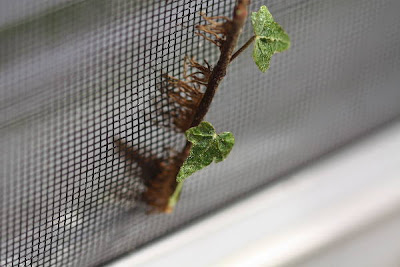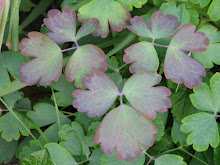Yesterday, I was idly looking outside when I noticed some unusual movement. I saw something small streaking across the water of the pond, leaving a trail of ripples in its wake. In a flash, I was at the window with the binoculars. At first, I thought it was some strange aquatic bird, but once I adjusted the lenses I saw immediately that it was a beaver. We'd heard from the prior homeowners that our pond contained beavers, but I'd never seen one. However, I'd definitely seen evidence.
Look at this tree:
...and this one:
We have to be careful with our pond-side trees, because these, unfortunately, are done for. Their phloem has been removed...that thin layer that transports sugar and the other benefits of photosynthesis from the leaves to the roots. They'll slowly die, and then will need to be removed. Todd and I will need to protect the accessible parts of the remaining trees from these industrious little fellows!
Most of our trees are fine, thankfully. I was walking there today, by the water's edge, instead of doing my work...but it's such a beautiful day.
I am nearly positive that the little patch of green on the left side of the photo is a group of flags, which should send up flowers in the next month. I'll have to keep an eye on it to see if I'm right.
I spotted some decidedly lumpy logs on the other side of the pond. Turtles!
Judging by the pronounced beaks and whip-like tails, these are snapping turtles (Chelydra serpentina). The serpentina of their latin name refers to their neck, which is unusually long and snake-like. I learned as a young child to leave snapping turtles alone, because they had grumpy dispositions and did not hesitate to use their long, limber necks and fearsome beaks to fasten on to the nearest child. I've learned, though, that like most things in nature, they just wish to be left alone and don't bite if unprovoked.
Decidedly gentler in nature are these yellow-bellied sliders (Trachemys scripta scripta). Their yellow-streaked necks, legs, and undersides of shells make them easy to identify.
Sigh...one day I'll get that high-quality zoom lens! Until then, you'll have to imagine those identifying yellow streaks.
I was absolutely delighted to see a row of them clustered on a half-submerged log.
Look how they're piling up on each other to fit as many turtles as possible onto the log, to take advantage of the sun! I was so pleased as I watched them turning their heads and occasionally readjusting their perches. I had to smile, thinking of a passage from Susan Allen Toth's My Love Affair With England. She described a badger-viewing trip with an enthusiastic local: "Mr. Fursdon was completely caught up in their antics. 'Oh, golly,' he said with pleasure. 'What a party they're having!'" Now, a turtle party is definitely more sedate than a badger party, but at that moment, I knew exactly how Mr. Fursdon felt.
I reluctantly left the turtles to their sunbathing and did a little more exploring of the property. We've had continually green ferns throughout the winter, but I was happy to see that our previously crumpled holly ferns have smoothed out and become lush and green.
They're putting up stalks, which unfurl into shiny new fern fronds.
I've been watching these vines, which are staked up around the house. They appeared dead, but many vines are dormant in the winter.
Look! New growth!
As soon as I saw the seedhead, I knew they were clematis vines.
As Mr. Fursdon would say: Oh, golly!
Todd and I worked in this area over the weekend. The vines had formed great mats over the brick and were tearing into the mortar.
It grew into the window screens with long, grasping fingers.
Look, underneath those vines is a window box!
Later this spring, I will plant pale pink climbing roses by the window, the most fragrant variety I can find. The three azalea bushes will bloom white, and it will be a cozy place, indeed, to sit on a bench and watch the birds.
Now for the most part, of course, I must wait to see what comes up on the property before doing my own digging and planting. But some plants are just not negotiable. For example, I must have columbines.
I've felt a strange pang recently, thinking of my old garden in Indianapolis. Right now, the columbines would have leafed out and would be getting ready to put up pale green stalks. The hydrangea branches would have firm, small leaves at regular intervals. My lilacs - oh, my lilacs! - would have tight, compact buds that would lighten and swell before bursting open into sweet-smelling purple clusters. Soon, the tentative red peony stalks will be breaking through the dirt.
I'm trying, somewhat unsuccessfully, not to think of it. I'm concentrating on reproducing parts of that garden here. I found a bag of columbine seeds, harvested from my plants in 2012. Before I can plant them, though, they must be cold-stratified. That is, I must mimic the experience of winter dormancy. Without this, they likely will not grow.
I sprinkled them on a wet paper towel...
...and wrapped them up in a baggy. It will be in the refrigerator for two weeks, and then I'll try to sprout them.
Some of our neighbors dropped off tulips recently...
...so I baked a large batch of chocolate chip cookies as a thank you. I am definitely like Andy from The Office in that regard (link: do not test my politeness.) - I'm always anxious to return the favor!
Quickly snapped before packing...
The cookies are a spin on the famous New York Times chocolate chip cookie recipe, which involves refrigerating the dough for up to 72 hours before baking. That lengthened the time before gift reciprocation, which caused a bit of stress, but I felt happy as I delivered the cookies today.
This recipe creates cookies with a crispy exterior and a soft interior. I'm a soft-all-the-way-through sort of girl, so it wasn't my favorite recipe, but it was rich and buttery. You can find the original recipe at Smitten Kitchen.
I hope you're enjoying a bit of spring - or at least the promise of it - in your neck of the woods!
Have a great week!
Subscribe to:
Post Comments (Atom)

























No comments:
Post a Comment